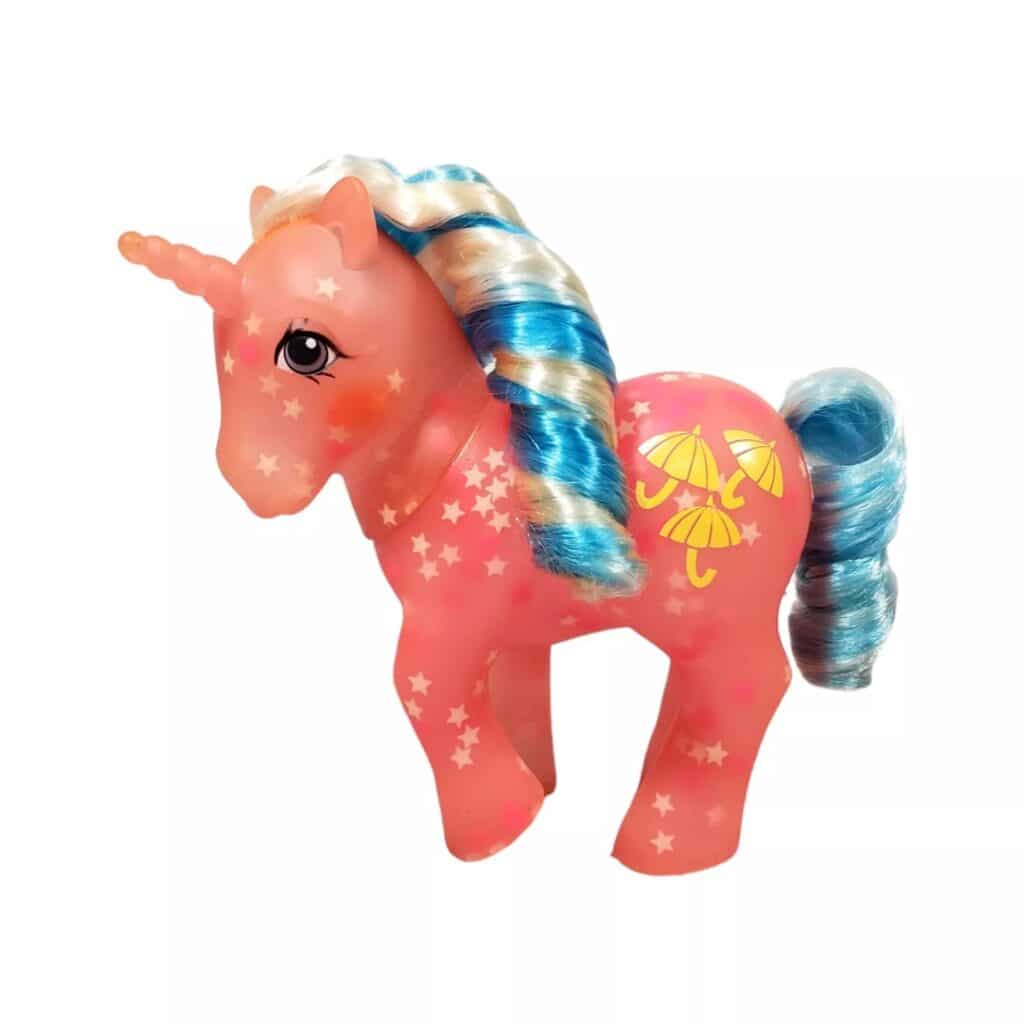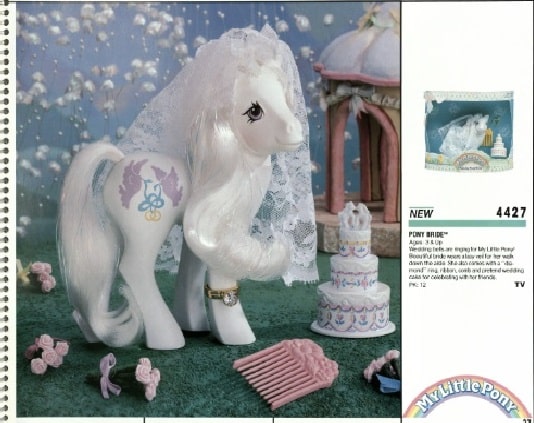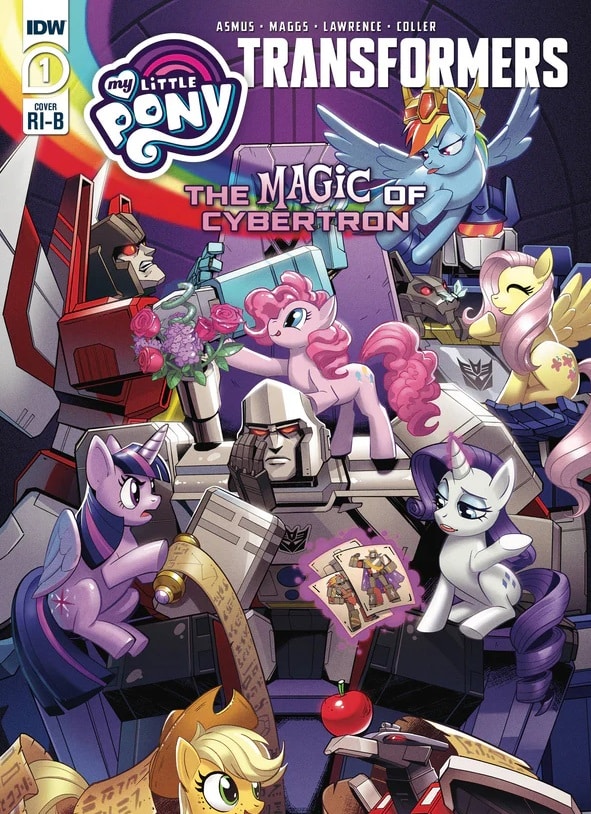My Little Pony invites children in the age-old play of hair grooming, brushing, and braiding. The ponies encourage fantasy, narrative, and storytelling. The variety of figures promotes collecting as a pastime. And, at the heart of it all, the ponies acknowledge many children’s fascination with horses. The continued popularity of the line proves that this brand—pardon the pun—has legs and has earned its place as a 2024 inductee to the National Toy Hall of Fame.

Hasbro based My Little Pony on their earlier My Pretty Pony. At about 11 inches high, My Pretty Pony was made of hard plastic and came in one color—brown with a white blaze. What made it endearing was the trigger beneath its chin that twitched its ears, winked its eyes, and swished its tail. Despite My Pretty Pony’s relative success, a Hasbro executive’s wife suggested that kids wanted a pony that was smaller, softer, and fun to brush. The Research and Design team soon got to work on a new concept. Hasbro filed a patent for My Little Pony in 1981 and listed Bonnie Zacherle, Charles Muenchinger, and Steven D. D’Aguanno as the inventors. Hasbro designer Maureen Patterson recommended the ponies come in pastel colors rather than natural colors. In a trial of test ponies, it was clear that children loved fantasy colors.

In 1983, Hasbro trotted out My Little Pony, six petite horse figures, each made of a soft vinyl with a silky mane and unique rump mark (symbols like stars, dots, and flowers later referred to as “cutie marks”) that reflected its name. The first characters of the line—Cotton Candy, Butterscotch, Blossom, Blue Belle, Minty, and Snuzzle—and the ponies that followed, had rounded bodies and anthropomorphized faces that made them irresistible. More varieties including Pegasus Ponies, Unicorns, and Sea Ponies followed.
My Little Pony combined doll play with modern marketing strategies. Hasbro understood the importance of storytelling and developing character personalities to expand play and collectability. Detail-oriented kids and adults coveted the latest pony with a new cutie mark. Hasbro also hired industrial designer Khipra Nichols to create play sets like My Little Pony Dream Castle, which included Spike, a baby dragon who rode up and down the castle in a basket inspired by a dark scene in the 1954 Alfred Hitchcock movie Rear Window.
By 1984, Sunbow Productions, an animation studio created by Hasbro’s ad agency Griffin Bacal, partnered with Marvel to create the My Little Pony (rebranded Rescue at the Midnight Castle) television special followed by Escape from Catrina. In “Toy Makers Frolic in Fantasy Land,” a New York Times article published two days before Christmas in 1984, Philip S. Gutis explored this new “prepackaged fantasy” trend in toy marketing. Gutis reported that some parents and children’s advocacy groups worried that these background stories prevented children from using their own imaginations. In response to the concerns, a Hasbro spokesperson said, “we give children the framework and they fill in the blanks and expand the fantasy.”
When My Little Pony: The Movie hit theaters just two years later, film reviewers criticized it as “the longest self-advertisement.” Despite the all-star cast including Danny DeVito, Cloris Leachman, Madeline Kahn, and Rhea Perlman, one reviewer noted “the real theme song is the ring of the cash register as Hasbro attempts to turn unwitting young viewers into customers.” Another observed “the sugary cuteness of My Little Pony masks a corporate greed as cold and sharp as a razor blade.” In her review, Nina Darnton declared “the little ponies are like those pastel heart candies that have little messages on them such as ‘I luv you.’ You can eat a few, but too many make you sick.” While these snarky commentors expressed concerns about children being immersed in consumer culture, they often failed to acknowledge that kids have independent thoughts, use their imaginations to fuel play, and demand that brands live up to their high expectations.
By the time Hasbro discontinued the My Little Pony line in the United States in 1992, the brand had sold more than $1 billion worth of toys, clothing, home decorations, and other consumer goods. Many felt it was time for Hasbro to get off their high horse, as My Little Pony licensing deals seemed to run wild, but its popularity never truly died. Hasbro re-launched My Little Pony in the U.S. and continues to introduce new products today.

Many fans credit My Little Pony: Friendship is Magic with the resurgence in popularity. Lauren Faust, the show’s creator, wanted to change the negative perceptions of animated programs geared toward girls. She wrote that the show was “wonderfully free of ‘token girl’ syndrome, so there is no pressure to shove all your ideals of what we want our daughters to be into one package.” The show also appealed to an unexpected audience—males between 13 and 35 who labeled themselves “bronies.” My Little Pony proved that unbridled femininity comes in many forms and continues to suggest that toy aisles don’t need to be defined by gender. In 2020, Hasbro did a cross-over between two of this year’s inductees My Little Pony x Transformers, further disrupting the gender stereotypes that were fervent when the toys came out in 1984.


